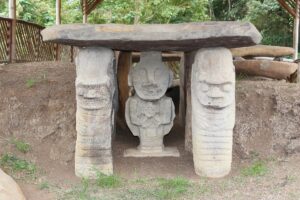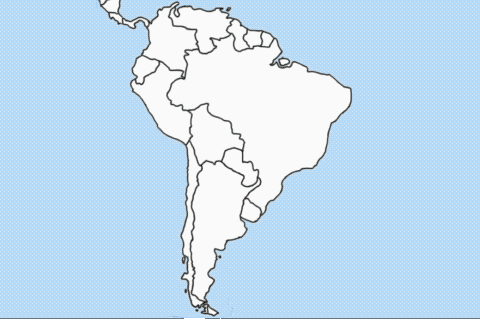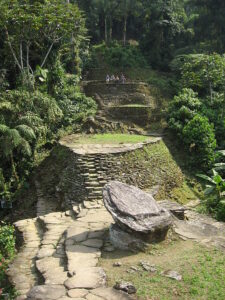In the Beginning There Were Mountains, Colombian History Pt. 1

Justin Hauver
This is the first part of a series on Colombian history written to help me make sense of the country’s past. Education research (all research?) depends on an awareness of context, including historical context. Besides, I was curious and I like reading about history.
Three mountain ranges stretch across Colombia’s geography, history, and culture. “In the beginning there were mountains,” writes David Bushnell, marking the cordilleras as prime movers through which rivers, life, and imaginations flow. They are the backdrop and the fountain, giving rise to stunning biodiversity adapted to Andean peaks and to all of the gradients that fade into lush savannas, tropical coastlines, tierra caliente grasslands, and Amazonian rainforests. These biomes are second only to Brazil’s in flora diversity and they are home to more species of birds than any other nation, twice as many as the US!

Early Human History
Migration pressures and our standard human capacity to muddle along into the unknown brought the first people from Central America to the Magdalena River around 25,000 years go, give or take 15,000 years. Dispersion, geographical fragmentation (remember the mountains!), and new waves of migration produced a variety of cultures. What little we know of these earliest people comes filtered through the erosion of millennia and the destruction of genocidal conquistas. Of course, I only know the tiniest fraction of the “we” that does real research or the “we” that lives into their ancestral histories. So here are the broad strokes that I can piece together.
Many of the oldest human settlements in South America are located in Colombia. El Abra, near Bogotá, dates back around 13,000 years, making it a contender for the oldest known evidence of our species’s existence on the continent (Bushnell). Beyond the familiar archaeological inferences about diet, organization, etc., not much is known of these early ancestors. Even more recent sites, like San Agustín (1500 years old) near the Magdalena’s origin or la Ciudad Perdida (inhabited between the 8th and the 14th centuries) near the mouth of the river, shed only scattered and mysterious light on the peoples who built them (Davis). As is true everywhere, it’s difficult to know what life was like so long ago, before phone cameras started documenting everything.

How, then, do we gain some insight into Colombia’s ancient history? One way is to change the starting point of our inquiry from the past to the present. That is to say, we can begin in the contemporary and make genealogical inferences backwards several hundred years in order to put together an outline of salient historical details.
Today, around 4% of Colombians self-identify as indigenous and millions more likely have some indigenous ancestry. Using language as an imperfect proxy for group identity, most contemporary Colombians with native roots can trace their lineages back to the Arawakan, Chibchan, or Carib language families. Separated by different histories and by the mountains around which they were spoken, these languages are “as different one from the other as Mandarin and English, Russian and Yoruba” (Davis). Stark linguistic differences hint at diverse origins, histories, and ways of being in the world.

Arawak
From the mouth of the Amazon River, Arawakan speakers spread out in several directions to become the most widespread language family in South America and the Caribbean. They built small, independent communities along the Amazon River, on the northern coast of the continent, and across the Antilles. The Tainos, an island Arawakan people, formed a relatively peaceful and mostly non-hierarchical society with wide networks of trade. They were the first indigenous group to see white men, who then drove them and many other groups out of existence. Arawakan decedents in Colombia today are concentrated on the Guajira peninsula in the north and in the Amazon Rainforest in the south.
Carib
Those who spoke Carib migrated from central Brazil to the northern coast of South America. They had an aggressive, loosely organized culture that extolled the individual warrior and drove them to conquer several islands from the Arawaks. Unverified rumors even claimed that they ate human flesh. This piece of gossip teamed up with etymological contortions to give us “cannibal” as well as the name of the Caribbean Sea over which the Carib presence loomed so menacingly in the minds of Europeans. When we look behind projections, however, history makes it clear that it was the white settlers who colonized, exploited, and chewed up many Cariban populations. Nowadays, Colombian Cariban speakers are largely located in the northern Andean foothills.
Chibcha
Chibcha started in Central America and was taken south into central Colombia by people who made homes in mountain valleys. Of the three linguistic groups discussed here, the Chibcha were the most numerous, the most hierarchically organized, and their lands contain the earliest evidence of human existence. The two main groups were the Tairona and the Muisca. Both were organized into kingdoms, with clan leaders paying tribute to the Zipa or Zaque who ruled over more than half a million people.

The Muisca, with two kingdoms centered around Bogota and Tunja, had the largest population concentration between the Incan and Mayan empires. Large scale potato farming and corn beer sustained the people. Gold was seen as the sacred embodiment of light, the one creator, and was often used in religious ceremonies. One clan was even said to perform a ritual in which the chief covered himself in gold dust and plunged into a lake, which gave rise to the myth of El Dorado that so consumed conquistadors. Occasionally, children were sacrificed to feed the sun and bring good fortune.
The Tairona were located near present day Santa Marta, in the foothills and mountains. They shared many similarities with the Musica, though they are thought to have been more advanced in engineering and artwork. La Ciudad Perdida, built 650 years before Machu Picchu, was once a central part of their lands.
Unlike Arawak and Carib, Chibcha did not survive colonization. The weight of Spanish exploitation fell heavily on the Musica and Tairona because of their centrally located, fertile lands and because their large populations were seen as potential encomienda workers. Like their now famous city, the Tairona were almost completely wiped from memory. The Musica are better remembered, but pressures to assimilate did much to erase their cultural identity. Chibcha was declared extinct around the year 1800 (Davis).
Conclusion
Each of the three language families discussed here has offshoots that intertwine and blend into one another. There are also an array of other languages and cultures that haven’t discussed. The richness and complexity of indigenous histories mirrors the diversity of Colombia’s natural beauty. A short blog post by an outsider like me cannot capture their stories with any real depth. It is nevertheless important to ground my thinking in some awareness of the indigenous cultures that shaped Colombian history and continue to shape the present with their persistent calls for recognition and justice.
Sources
The Making of Modern Colombia: A Nation in Spite of Itself by David Bushnell
Magdalena: River of Dreams by Wade Davis
Various articles.
Note: All views expressed are my own, they do not represent the Fulbright or any other organization.